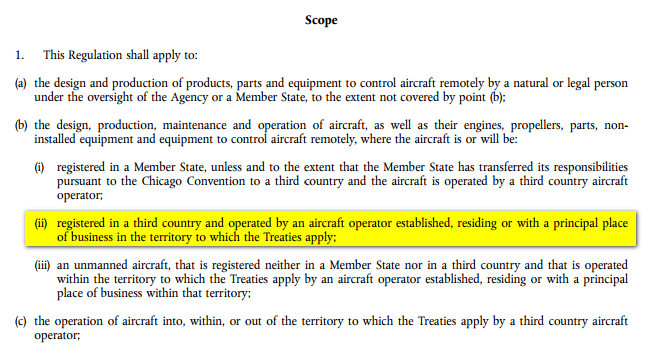[ local copy ]
Is there a summary of what this changes?
Does the EU publish changes to documents?
When I see one of these I search it for the words “third country” 

Has this wording changed?
Looks like they plan to tighten the grip on Annex I (aka Annex II) aircraft ? This is new at least:
It would not be appropriate to subject all aircraft to common rules. In particular, in light of their limited risk to
civil aviation safety, aircraft that are of simple design or operate mainly on a local basis, and those which are
home-built or particularly rare or only exist in a small number, should remain under the regulatory control of
the Member States, without any obligation under this Regulation on other Member States to recognise such
national arrangements. However, in order to facilitate the development of national rules for aircraft falling outside
the scope of this Regulation, the European Union Aviation Safety Agency (‘the Agency’) can adopt guidance
material for that purpose
and
However, provision should be made for the possibility to apply certain provisions under this Regulation to
certain types of aircraft which are otherwise excluded from the scope of this Regulation, especially those which
are produced in an industrial manner and which could benefit from free circulation within the Union. Therefore,
organisations involved in the design of such aircraft should be allowed to apply for a type certificate to the
Agency or, if applicable, to make a declaration to the Agency in respect of an aircraft type which is to be put on
the market by such organisations
Looks like type certificate or an industrial standard for microlight.
Peter wrote:
I recall someone in the certification business telling me that CS23 is getting easier than UL
 Only “someone in the certification business” would even think for half a fraction of a second in such a direction. I must admit though, not entirely untrue perhaps, but very depending on the point of view. One must not dismiss the fact that a stamp with “According to EASA CS-23” will sell more planes, at least the more expensive ones. Also when starting from scratch on a new design, it would be plain stupidity not to do it according to some EASA specification – if even only for future eventualities and easier adaption throughout the entire EASA-land. But designed according to, and certified according to, are two very different things.
Only “someone in the certification business” would even think for half a fraction of a second in such a direction. I must admit though, not entirely untrue perhaps, but very depending on the point of view. One must not dismiss the fact that a stamp with “According to EASA CS-23” will sell more planes, at least the more expensive ones. Also when starting from scratch on a new design, it would be plain stupidity not to do it according to some EASA specification – if even only for future eventualities and easier adaption throughout the entire EASA-land. But designed according to, and certified according to, are two very different things.
I have actually been through the whole process of approving a microlight for Norway. It wasn’t that much work because it was already approved in Germany. It was not approved in the UK, and still isn’t as far as I know, due to a special design of the wing spar. EASA approved, or a declaration to an EASA standard would make all this “approving” for every country unnecessary of course.
Well, maybe not such a bad idea after all, at least not for factory built aircraft. It will be interesting to see what becomes out of this.
Always winners and losers. If a UL had an ICAO CofA it would be better in perhaps all respects except
which is, ahem, quite a lot of things to quite a lot of people!
Perhaps the manufacturer could sell a CS23 version and a UL version 
I used to know a pilot who climbed up the GA food chain all the way to a King Air and who had an amazing ability to take a 1000 page EASA paper and produce an executive summary of it in a day. Unfortunately AFAIK he finally succumbed to family pressure and stopped flying.
Unfortunately AFAIK he finally succumbed to family pressure and stopped flying.
He can still be prevailed upon to do some intellectual work, thankfully.
But the expert on this on is Bookie, I think.